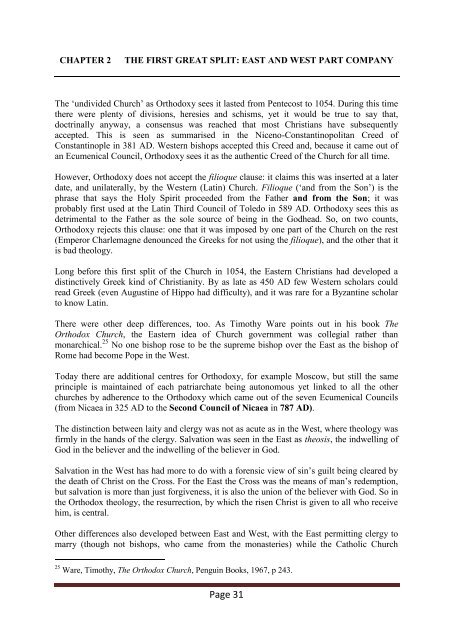Digging Out the Embedded Church - The Maranatha Community
Digging Out the Embedded Church - The Maranatha Community
Digging Out the Embedded Church - The Maranatha Community
Create successful ePaper yourself
Turn your PDF publications into a flip-book with our unique Google optimized e-Paper software.
CHAPTER 2 THE FIRST GREAT SPLIT: EAST AND WEST PART COMPANY<br />
<strong>The</strong> „undivided <strong>Church</strong>‟ as Orthodoxy sees it lasted from Pentecost to 1054. During this time<br />
<strong>the</strong>re were plenty of divisions, heresies and schisms, yet it would be true to say that,<br />
doctrinally anyway, a consensus was reached that most Christians have subsequently<br />
accepted. This is seen as summarised in <strong>the</strong> Niceno-Constantinopolitan Creed of<br />
Constantinople in 381 AD. Western bishops accepted this Creed and, because it came out of<br />
an Ecumenical Council, Orthodoxy sees it as <strong>the</strong> au<strong>the</strong>ntic Creed of <strong>the</strong> <strong>Church</strong> for all time.<br />
However, Orthodoxy does not accept <strong>the</strong> filioque clause: it claims this was inserted at a later<br />
date, and unilaterally, by <strong>the</strong> Western (Latin) <strong>Church</strong>. Filioque („and from <strong>the</strong> Son‟) is <strong>the</strong><br />
phrase that says <strong>the</strong> Holy Spirit proceeded from <strong>the</strong> Fa<strong>the</strong>r and from <strong>the</strong> Son; it was<br />
probably first used at <strong>the</strong> Latin Third Council of Toledo in 589 AD. Orthodoxy sees this as<br />
detrimental to <strong>the</strong> Fa<strong>the</strong>r as <strong>the</strong> sole source of being in <strong>the</strong> Godhead. So, on two counts,<br />
Orthodoxy rejects this clause: one that it was imposed by one part of <strong>the</strong> <strong>Church</strong> on <strong>the</strong> rest<br />
(Emperor Charlemagne denounced <strong>the</strong> Greeks for not using <strong>the</strong> filioque), and <strong>the</strong> o<strong>the</strong>r that it<br />
is bad <strong>the</strong>ology.<br />
Long before this first split of <strong>the</strong> <strong>Church</strong> in 1054, <strong>the</strong> Eastern Christians had developed a<br />
distinctively Greek kind of Christianity. By as late as 450 AD few Western scholars could<br />
read Greek (even Augustine of Hippo had difficulty), and it was rare for a Byzantine scholar<br />
to know Latin.<br />
<strong>The</strong>re were o<strong>the</strong>r deep differences, too. As Timothy Ware points out in his book <strong>The</strong><br />
Orthodox <strong>Church</strong>, <strong>the</strong> Eastern idea of <strong>Church</strong> government was collegial ra<strong>the</strong>r than<br />
monarchical. 25 No one bishop rose to be <strong>the</strong> supreme bishop over <strong>the</strong> East as <strong>the</strong> bishop of<br />
Rome had become Pope in <strong>the</strong> West.<br />
Today <strong>the</strong>re are additional centres for Orthodoxy, for example Moscow, but still <strong>the</strong> same<br />
principle is maintained of each patriarchate being autonomous yet linked to all <strong>the</strong> o<strong>the</strong>r<br />
churches by adherence to <strong>the</strong> Orthodoxy which came out of <strong>the</strong> seven Ecumenical Councils<br />
(from Nicaea in 325 AD to <strong>the</strong> Second Council of Nicaea in 787 AD).<br />
<strong>The</strong> distinction between laity and clergy was not as acute as in <strong>the</strong> West, where <strong>the</strong>ology was<br />
firmly in <strong>the</strong> hands of <strong>the</strong> clergy. Salvation was seen in <strong>the</strong> East as <strong>the</strong>osis, <strong>the</strong> indwelling of<br />
God in <strong>the</strong> believer and <strong>the</strong> indwelling of <strong>the</strong> believer in God.<br />
Salvation in <strong>the</strong> West has had more to do with a forensic view of sin‟s guilt being cleared by<br />
<strong>the</strong> death of Christ on <strong>the</strong> Cross. For <strong>the</strong> East <strong>the</strong> Cross was <strong>the</strong> means of man‟s redemption,<br />
but salvation is more than just forgiveness, it is also <strong>the</strong> union of <strong>the</strong> believer with God. So in<br />
<strong>the</strong> Orthodox <strong>the</strong>ology, <strong>the</strong> resurrection, by which <strong>the</strong> risen Christ is given to all who receive<br />
him, is central.<br />
O<strong>the</strong>r differences also developed between East and West, with <strong>the</strong> East permitting clergy to<br />
marry (though not bishops, who came from <strong>the</strong> monasteries) while <strong>the</strong> Catholic <strong>Church</strong><br />
25 Ware, Timothy, <strong>The</strong> Orthodox <strong>Church</strong>, Penguin Books, 1967, p 243.<br />
Page 31








